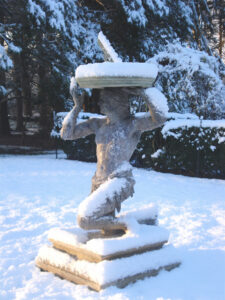Winter Weather Notes
 Antique garden ornament requires ongoing preservation and care. We recommend regularly consulting a professional conservator and committing to periodic conservation treatments.
Antique garden ornament requires ongoing preservation and care. We recommend regularly consulting a professional conservator and committing to periodic conservation treatments.
FREEZING CLIMATES
Winter wind, snow, and ice can be very damaging to antique garden ornament. We suggest taking the following measures to protect your outdoor antiques:
During winter in freezing climates, it is very important to raise your garden antiques off the bare soil/grass to avoid their freezing to the ground. For example, we suggest putting cast-iron benches up on bricks (one under each leg is sufficient). We also recommend installing permanent cement footings in the ground. Cement footings are particularly needed under heavy statuary that cannot be moved easily. Footings are also more level than bare ground, giving extra stability to your ornaments.
WINDY LOCATIONS
In windy locations, objects should be attached to pedestals or secured to permanent structures with cords. Or they can be taken down from pedestals and placed flat on a cushioned support. Portable pieces, particularly those made of terra cotta, stoneware, or composition stone will do better if taken indoors.
SURFACE PROTECTION
Unsealed cracks in a marble, stone, or composition stone object can collect water that may freeze and thaw causing further cracking. Therefore, we strongly recommend protecting all of your garden antiques with breathable polypropylene (see: Weatherbags). In Great Britain they use wooden sentry boxes, a way more traditional solution. These custom-built “houses” protect fragile statues from all kinds of winter weather.
CONTAINERS
All urns, birdbaths, and fountains should be emptied of soil and water before the first winter frost and covered and/or tipped over to prevent the build-up of damaging snow and ice. Planted containers are more at risk if the reservoir is filled with dirt. Water can still enter, collect, freeze, and thaw. Portable components, such as the tops of birdbaths, can be removed altogether, laid vertically against the pedestal, or stored indoors. Cast-iron urns with drainage holes are less susceptible to damage than stone, marble, or composition stone vessels, but measures should still be taken to protect their surfaces from moisture (see: Cast Iron).
MATERIALS
In general, we recommend bringing terra-cotta objects indoors during freezing months. Terra-cotta oil jars require particular care. Even if they have drainage holes, they should still be brought indoors or, at the very least, turned upside down. If moving the jar is impractical, consider having a custom-made lid of wood or metal constructed to fit over the opening to prevent the entry or accumulation of water in the bottom.
Composition (cast) stone is the most porous of garden ornament materials and requires careful attention in winter. Bases of statues that sit in snow all winter have been known to crack and fall apart. If, when you’re buying a composition stone piece, you see an exposed piece of a rusty iron armature, be cautious and reconsider the purchase. This is a serious condition problem.